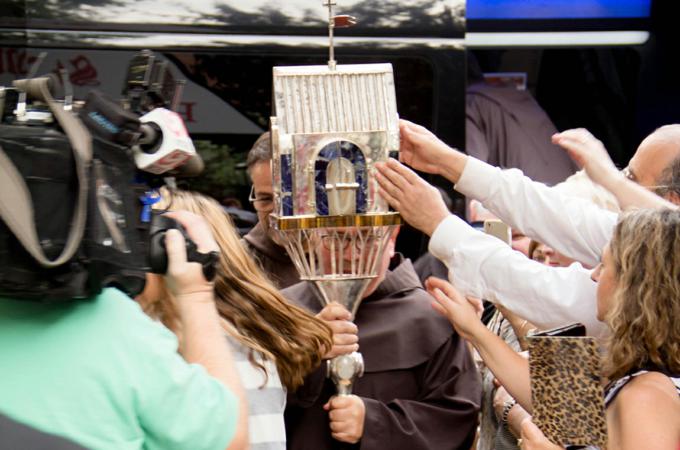Padre Pio is a 'saint of our times,' says foundation director
They came by the thousands. To Lowell. To Boston. To Braintree.
Young and old, infirm and able-bodied, they stood for hours in line for the opportunity to venerate the heart of St. Pio of Pietrelcina -- Padre Pio. Some held rosaries or prayer cards up to the relic; others quietly prayed in front of the heart of the saint.
"It really should be no surprise to anyone that Padre Pio appeals to so many people," explained Father Mariano Di Vito, director of the Fondazione Voce di Padre Pio in San Giovanni Rotondo and one of the Capuchin friars who brought the relic to Boston.
Speaking in his native Italian, Father Di Vito noted that "Padre Pio brings with him hope -- you can see it on the faces of the people who have come to venerate him. They arrive with a need, or an intention, or even with nothing but curiosity to see this heart, but when they leave, they leave with a renewed hope in their lives."
Father Di Vito believes this is because St. Padre Pio is a "saint of our times."
"He can relate to us because he was walking this earth not too long ago," he said. "There are many who have come -- particularly the elderly -- who were alive when he was walking the earth."
St. Padre Pio "knows the crisis in people's lives," continued Father Di Vito. "He knows the suffering of workers, of immigrants, of families, of the poor ... and people come to him because they know he had an authentic faith."
Father Di Vito explained how, during his lifetime, Padre Pio would often spend hours in the confessional in the church at San Giovanni Rotondo, the small Italian village where he spent most of his life as a Capuchin priest. People would flock to him from Italy and throughout the world -- all with the hope of receiving guidance from him.
"His love was palpable," Father Di Vito said. "You could feel it physically -- in the confessional, at Mass, when he was in prayer. His was a total and complete love of God, and of the people of God."
According to Father Di Vito, this is one of the reasons that Domenico D'Ambrosio, the archbishop present in 2008 when St. Pio's remains were exhumed, decided to extract St. Pio's heart. Finding his body well-preserved in spite of 40 years passing since his death, Archbishop D'Ambrosio fitted his body with a silicone mask, and placed it on display at the shrine devoted to the saint. However, he placed the heart in a separate reliquary in order to allow pilgrims to pray in front of his heart, "Padre Pio loved so much: loved God, loved those he met, and loved the people of God -- and we are the people of God," Father Di Vito said.



















